Diamond Falls Botanical Gardens
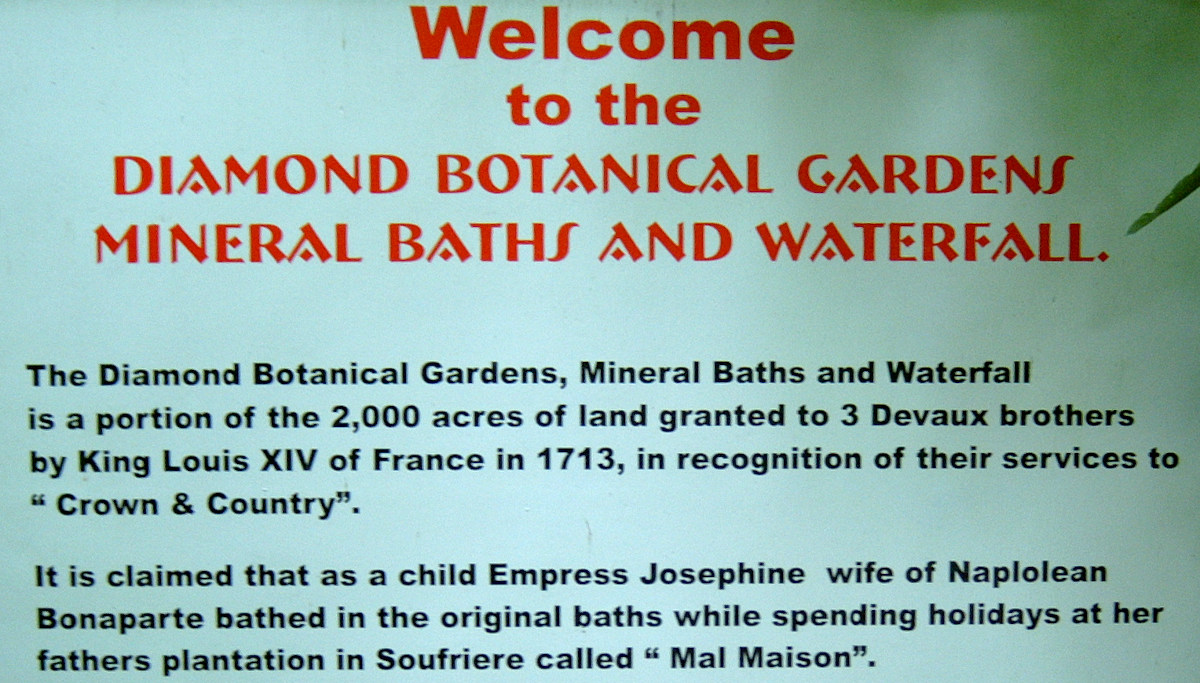
The Diamond Falls and mineral baths are consistently described as one of the natural wonders of St Lucia.
Table of Contents
The Diamond Botanical Gardens sit on the original site of the spring baths which were built in 1784. These baths were built so that the troops of King Louis XVI of France could take advantage of the waters therapeutic powers.
What can you see at the Diamond falls botanical gardens?
The Diamond Falls Botanical Gardens is both a historic and a naturally beautiful site. A haven for birds and insects, which gives one a true nature experience not to be duplicated anywhere within the Caribbean.
Diamond Botanical Gardens, the oldest botanical garden on Saint Lucia, is now a thriving tourism site, six acres of planted gardens, including Diamond Falls. The Diamond River comes straight from the Sulphur Springs, black from volcanic mud and spilling over the rock face, staining the stone wall with the many colours left behind by the minerals finally dropping into the calm pond below.
Below: You can see why Superman took the chance to visit Diamond falls gardens to pick flowers for Lois Lane.
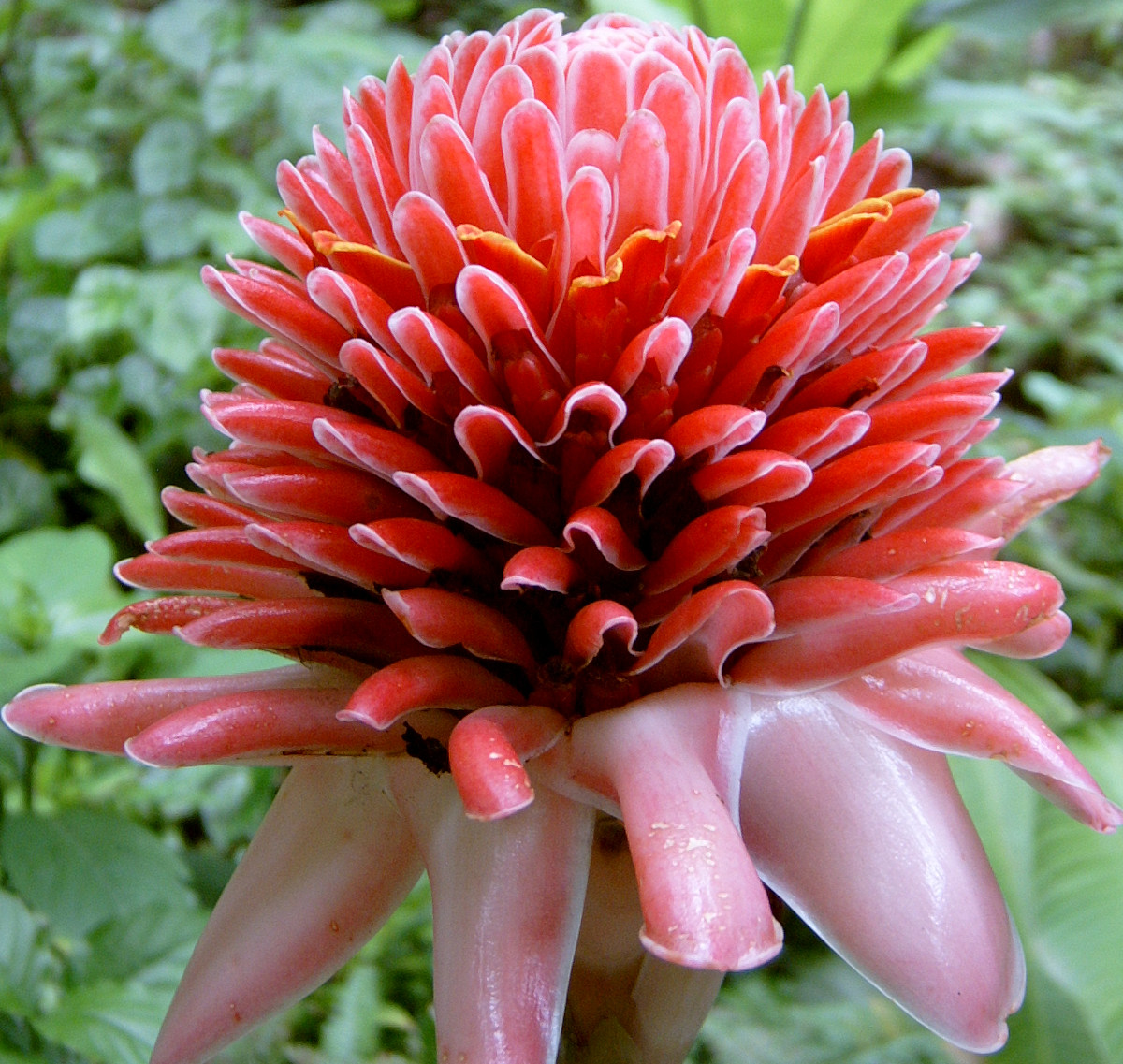
This historical estate has been transformed from a working plantation that once produced limes, copra and cocoa, into one of the major heritage sites in the region, as well as a viable and spectacular tourist attraction that includes the Botanical Gardens, Waterfall, Mineral Baths, Nature Trail, Old Mill Restaurant and the historic Soufriere Estate House.
Diamond Falls Botanical Gardens, a six acre multi-award winning tourism site, is an attractive, alluring and peaceful retreat from the outside world.
What to do at Diamond falls:
Enjoy the beauty and sultry warmth of the tropics whilst walking through lush fertile vegetation and marvelling at the diverse range of tropical flowers and plant life. Plan for 2 to 3 hours to see the whole site.
- See the waterfall and the gardens
- Take a bath in the Volcanic spring water
- Diamond falls is a haven for birds
- Historical building and waterwheel
You have just stepped into a world with a breath-taking waterfall, hot mineral springs fill the historical baths with age old medicinal waters and flora and fauna abounds.
Flowering bushes and shrubs of every type and colour were planted around and beneath the existing trees. Hibiscus, Ixora, Heliconia, Anthurium and the magnificent Balisier with their exotic blossoms and equally exotic names, now brighten the gardens. Due to the tropical climate there is no “best” season to see the gardens and they can be enjoyed all year round.
Below: Diamond falls is well maintained and easy to navigate.
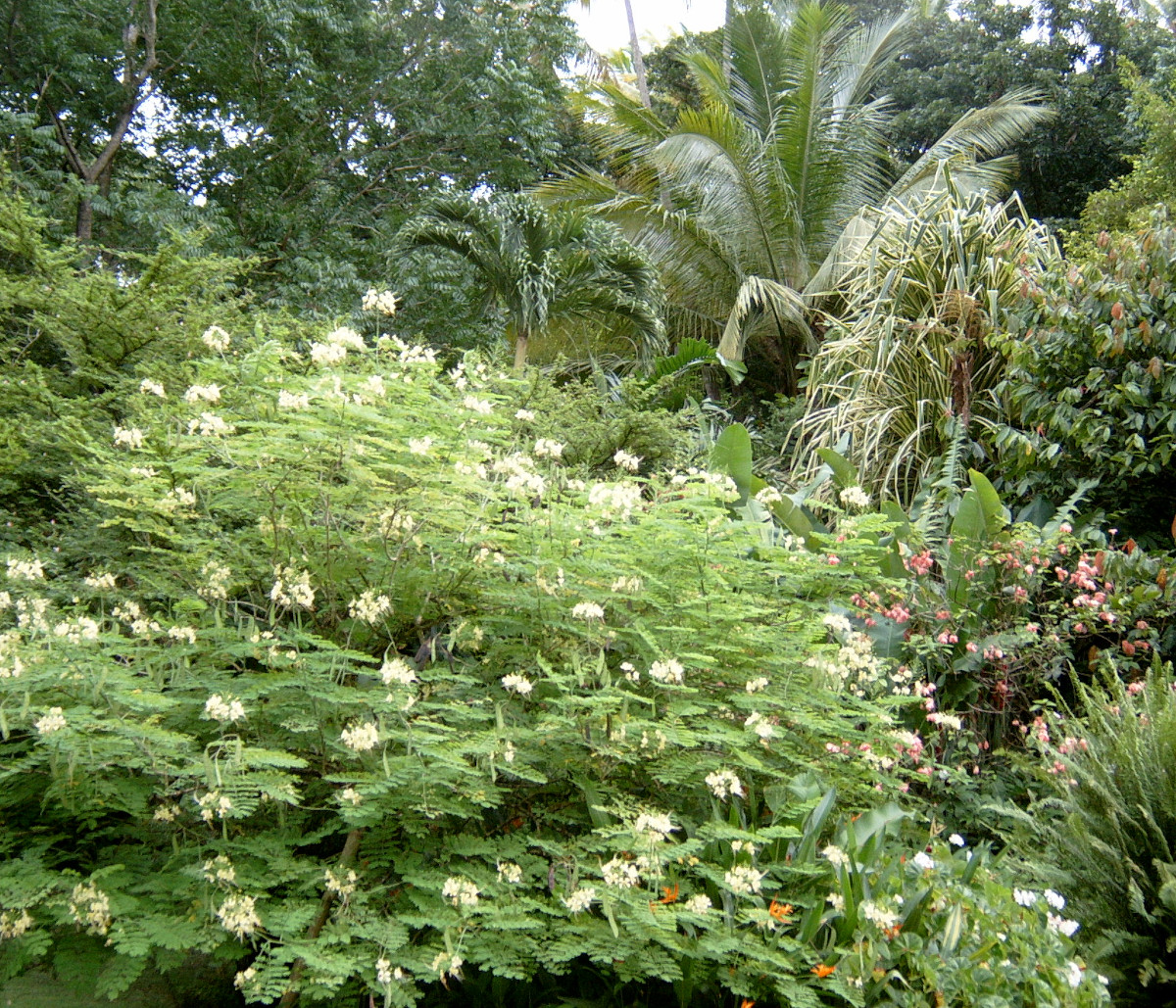
Soufriere Estate is one of the oldest and best-preserved estates on St. Lucia and was originally part of the 2000 acres of land granted to the Devaux family by King Louis XIV of France in 1713, in recognition of their service to ‘Crown and Country’, In 1740 the three Devaux brothers came to St. Lucia to claim the land which at that time included the present site of Soufriere Town, as well as the Sulphur Springs.
Below: Mushrooms and fungi in the botanical gardens.
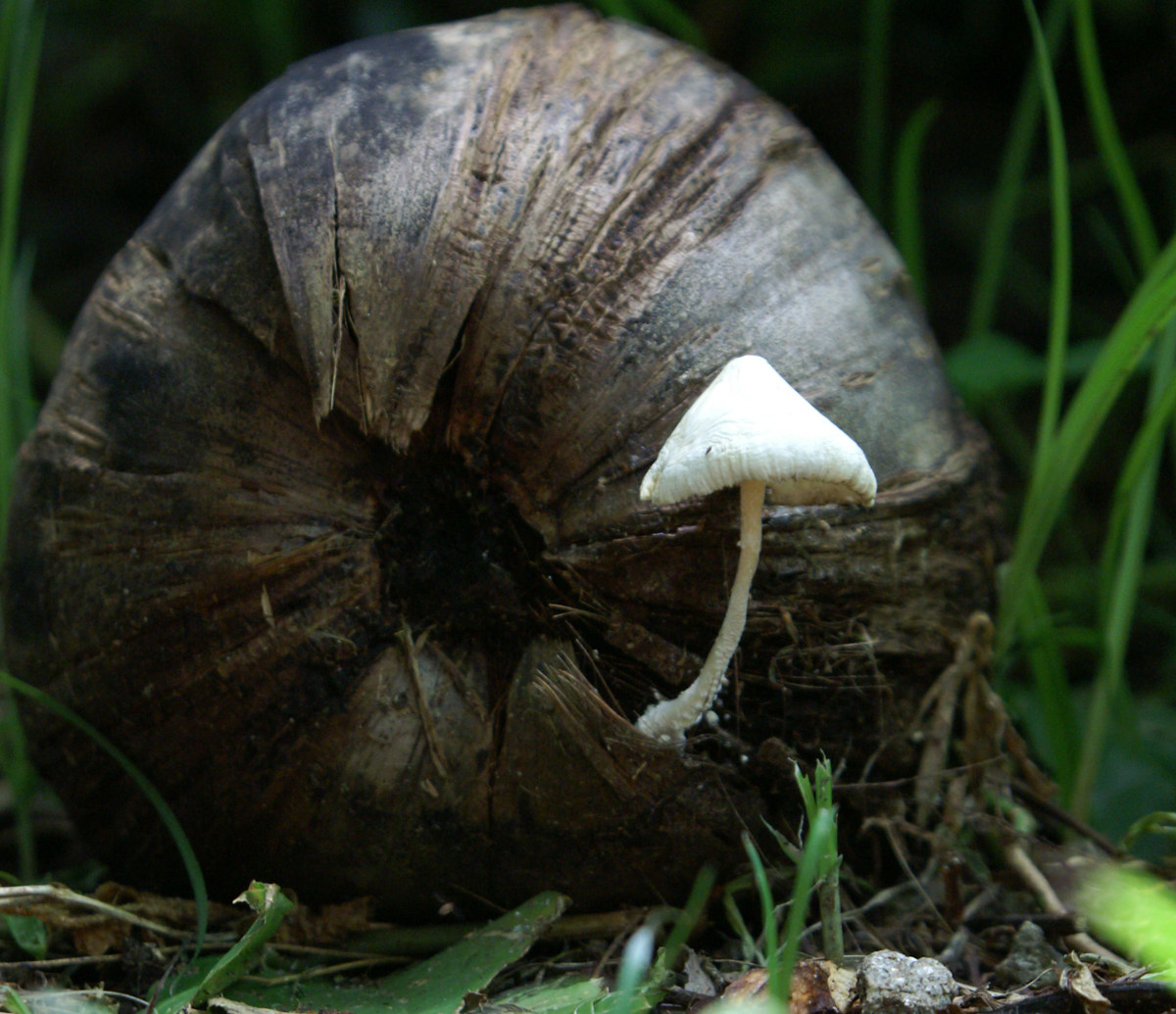
About Diamond Falls Botanical Gardens - The Diamond Botanical Gardens sit in a natural gorge that begins at the world’s only drive through volcano and bubbling sulphur springs. The sulphur springs are weak spots in the crust of an enormous collapsed crater, the result of a volcanic upheaval that took place some 40,000 years ago.The area is rich in Natural minerals and formations.
Below: The diamond water fall. A scene in "Romancing the stone" was filmed here.
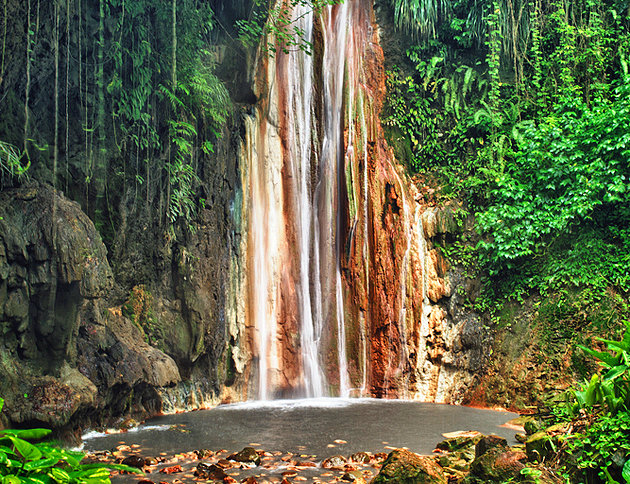
Diamond Water Fall:
The Diamond Waterfall is arguably the most colourful waterfall in the Caribbean and waterfalls are relatively rare here. It is less than a mile east of Soufriere town centre. What makes this waterfall stand out is that its waters were laced with minerals as its stream emanated from rainwater mixed with volcanism giving the falls a rather colourful appearance that seemed to change often.
At the Botanical Garden a well maintained path winds its way from the mineral baths through ferns and banana plants to a spot where the Diamond River drops into a picturesque waterfall.
This beautiful waterfall is approximately 17 metres in height and is a mixture of rainwater and volcanism fed by the Sulphur Springs.
The flow of water varies at different times of year but is always spectacular.The water is laced with minerals, sulphur, copper sulphate, magnesium, iron, manganese and calcium, all contributing to the kaleidoscope of colours that adjourn the rock face behind the falls.The rock face continues to change colour depending on the mineral content at any given point in time.
The therapeutic Powers - In 1784, the Baron de Laborie, who was at the time Governor of St. Lucia, sent samples of the mineral water to Paris to be analysed by the “Medicine du Roi”. The waters from the Diamond Springs were found to have similar properties as the famous Aix-les-Bains in France and Aix-la-Chapelle or Aachen in Germany.
Bathing in these waters have always been recommended for persons who suffer from chronic rheumatism, respiratory complaints or ulcers, an opinion supported by John Davy in circa 1850, M.D., the Inspector General of military hospitals in the West Indies. Or even to have a splash in the warm water.
King Louis XVI was impressed by Medecin de Rois analysis of the waters. He allocated the necessary funds to have a stone building containing 12 stone baths erected. The baths were put to good use for several years, but during the Brigands war circa 1794- 1798 that followed on the heels of the French Revolution, the bath house, like so many other buildings, was destroyed.
The baths stayed in a state of ruin until André du Boulay, the last previous owner of Diamond Estate, restored them for his private use. Later with further restoration and the addition of modern bathroom facilities, these baths were then made available to the public.
In 1983, Mrs. Joan Devaux, daughter of Mr. André du Boulay took over the management of the Estate. Throughout the years Mrs. Devaux has continued the development and restoration of this beautiful estate.
Where is the Diamond falls botanical park?
Located five minutes from the town square in Soufriere we are easily found whether you are coming from Castries, Vieux Fort, or the waterfront of Soufriere or anywhere in between.
Diamond Falls, Soufriere Estate, P.O. Box 1020, Soufriere, St Lucia, West Indies.
Tel: +1-758-459-7155
Email - soufestate@candw.lc
Directions:
From Castries: Take the west coast highway south to Soufriere. You will cross a single lane bridge as you come into town, stay on this street until you reach the town square (in the centre of town). In front of the green & white “ginger bread” storefront turn left. Stay on this street passing the Catholic Church on your left. Continue out of town, passing Soufriere Estate’s black gates. You will begin seeing signs at this point. Turn right at the first road beyond the gates and follow this road directly to the parking area of the site.
From Vieux Fort: Take the west coast road to Soufriere. You will come down a steep hill as you come into Soufriere. At the bottom of the hill you will come to the town square and Catholic Church. Turn right and stay on this road, passing Soufriere Estate’s black gates. You will begin seeing signs at this point. Turn right at the first road beyond the gates and follow this road directly to the parking are of the site.
From the waterfront of Soufriere: Come one block into town to the town square, turn left in front of the green & white “ginger bread” storefront. Continue, passing the Catholic Church on your left as you leave town. Pass the Soufriere Estate’s black gates turning right at the first road (you will see signs) and follow this road to the parking area of the site.
Opening hours:
Monday - Saturday: 10 am - 5 pm and Sunday / Public holidays: 10 am - 3 pm.
Cost:
Adults: US$7 / EC$17.50 Children: Half Price
Private Baths: US$7 - EC$17.50 Public Baths: US$6 - EC$15
Special discounts can be arranged for groups. Additionally, all prices are inclusive of VAT at 10%.
The nature trail leaves the gardens and winds between tropical rain forest following the old ridge trail that was once used to collect the harvested coconuts being brought to the estate’s copra ovens. The bird call of St. Lucian Orioles, Hawks, and Doves can be heard high up in the canopy. Many other bird species reside in this peaceful forest of second growth Red Cedar and Mahogany they call home.
At the trail’s end you will come to the Old Mill & Waterwheel, built in 1765, which was originally used to crush sugar cane. Later, after the devastation of the sugar industry the estate went into lime oil production. Inside the Old Mill you can still see the wooden vats that were used to ship the lime oil to Europe.
The waterwheel continued working crushing limes and then later was used to generate the very first electricity to the village of Soufriere. Each house had two light bulbs and the price for electricity was 1 shilling a month.
The first commercial electricity was hydroelectric and the water to power the hydro plant was supplied through the aqua duct that brings the water from the Soufriere River through Soufriere Estate. The river and aqua duct still supply water to the waterwheel today and can be seen at the Old Mill.
Diamond Falls Mineral Baths Spa - The mineral baths were originally built in 1784 for the French troops of King Louis XVI, so they could benefit from the therapeutic waters.
The two original baths were restored with a WATER TEMPERATURE THAT MAY REQUIRE YOU TO ADD COOLER WATER TO BRING TO A COMFORTABLE TEMPERATURE RANGE.
Additionally there are three pools feed from the overflow from the original tanks. These pool are situated in the open and the temperature of the water is pleasantly warm. The tepid water is clear and used by local bathers as well as visitors to the Island. Bathing in the waters is highly recommended for people who suffered from chronic rheumatism, sore joints and muscles.
On site there are changing rooms for visitor’s convenience and also a small shop and restaurant.